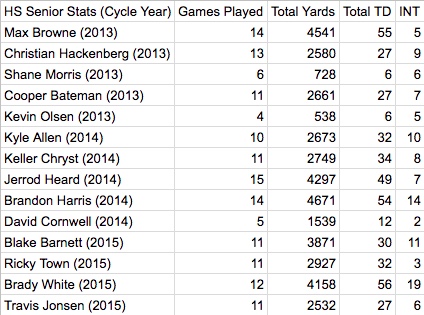Last summer, I took a look at the high school statistics of quarterbacks selected in the first round of the last three NFL Drafts. Unsurprisingly, the stats were impressive across the board. There were only a few outlier scenarios, like Carson Wentz’s injury-riddled career in North Dakota and Paxton Lynch playing in a Wing-T offense. I then moved on to college football’s top draft prospects entering the 2017 season- Josh Rosen, Sam Darnold, Baker Mayfield, Lamar Jackson, Josh Allen, Mason Rudolph- and found more of the same.
I’ve held the belief that a quarterback’s high school senior season, both video (did anyone look at Lamar Jackson's?) and production, is among the most important, yet overlooked, data points in the evaluation process prior to college.
A few reasons why this is so:
1) Recruiting is accelerated at the position. Most quarterbacks are committed prior to their senior seasons. College programs are making more of a projection and oftentimes don’t have the luxury of waiting to see how a QB performs in their last (and most telling) year.
2) As it pertains to recruiting networks and rankings- by December, most of the focus has shifted to coverage of the final homestretch of the cycle (and even more so now with the early signing period). Initial opinions are hardened and strengths/deficiencies that come to light in the preceding fall go unnoticed or are overlooked. There’s also an inherent exposure bias towards national all-star games and The Opening/Elite11 Finals- which offer an extended (and by no means insignificant) look at a limited number of top arms. These events don’t adequately account for running and improvisational ability, which is increasingly important when evaluating the position. That's not to mention the groupthink, confirmation bias and general overreaction that can occur at the events (I've been to them).
So why is the senior season important? It sounds obvious, but it’s real football and is typically the most favorable situation of the prospect's career. There is usually great familiarity within the offensive scheme and with teammates. They’re playing against younger defenders. A top prospect should dominate as a senior.
When compiling the stats, I combined passing/rushing yards and passing/rushing touchdowns. Placing more an emphasis on total yards and total touchdowns as opposed to strictly passing stats helps account for athleticism and running ability, while also keeping things concise. We've reached the point where most top quarterback prospects were a run threat at some point in their career and there’s never a more favorable situation to put up numbers on the ground than as a high school senior, even as a pass-first type. A top quarterback prospect should be among the best athletes on the field vs. high school competition. Interception total also offers a look at decision-making and ball placement.
The senior season stats for the recent first round picks and projected top picks in the 2018 draft are shown below. Paxton Lynch is omitted due to playing in the aforementioned Wing-T offense.
As you can see, this group is prolific with total TD/yards while limiting interceptions.
To take this a step further, let's look at the same stats for QB's who were top 100 prospects (2013-2015 recruiting cycles) according the 247Sports Composite who have yet to meet expectations. 12 of the 14 have transferred at least once from their initial college program (with Jerrod Heard moving to WR).
The group of first rounders/top draft prospects (with 4 of 13 being Elite11 finalists) averaged 281.2 total yards, 3.5 total TD and .48 INT per game. The second group of top 100 high school prospects (with 13 of 14 being Elite11 finalists) averaged 229.7 total yards, 3.0 total TD and .75 INT per game. The first group has better stats across the board, despite just 2 of the 13 being ranked as top 100 prospects per the 247Sports Composite.
Upon closer inspection, there's some trends and warning signs within the second group. You'll notice that they played less games than the first group- meaning there were more injuries and their teams weren't going as deep in the playoffs.
The second group also had significantly fewer rushing yards. Only 6 of the 14 rushed for over 300 yards on the season. 4 of the 6- Christian Hackenberg (53.6%), Brandon Harris (54.1%) Blake Barnett (59.2%), Travis Jonsen (54.5%)- didn't complete 60% of their pass attempts. The other two are Brady White (threw 19 interceptions) and Jerrod Heard (played in a run-first offense attempting 15 passes per game). Max Browne, a top 10 prospect in a high-powered offense, rushed for 15 yards as a senior. Jameis Winston is considered slow-footed by NFL standards and ran for 1,063 yards.
The senior season isn't everything. Physical skillset is the first hurdle in determining if a quarterback should be a prospect, but the two aren't mutually exclusive and the senior season the easiest way to help separate the best of the best. And there are certainly exceptions- Heisman Trophy winner Sam Bradford is one who had a rough final campaign- but the numbers are pretty clear that it's a better indicator than many other factors. The senior season shouldn't be ignored on the grounds of it being a large sample size and typically the final and most recent data point before the QB enrolls. Additionally, quarterbacks who are complete athletes (rushing yards/TD's) that don't turn the ball over (INT total) tend to fair well at the next level and there's no better indicator of that than their final fall in high school.
And to the recruiting fans that are curious how their 2018 signee stacks up:


